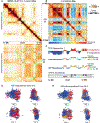Chromosome compartmentalization: causes, changes, consequences, and conundrums
- PMID: 38395734
- PMCID: PMC11339242
- DOI: 10.1016/j.tcb.2024.01.009
Chromosome compartmentalization: causes, changes, consequences, and conundrums
Abstract
The spatial segregation of the genome into compartments is a major feature of 3D genome organization. New data on mammalian chromosome organization across different conditions reveal important information about how and why these compartments form and change. A combination of epigenetic state, nuclear body tethering, physical forces, gene expression, and replication timing (RT) can all influence the establishment and alteration of chromosome compartments. We review the causes and implications of genomic regions undergoing a 'compartment switch' that changes their physical associations and spatial location in the nucleus. About 20-30% of genomic regions change compartment during cell differentiation or cancer progression, whereas alterations in response to a stimulus within a cell type are usually much more limited. However, even a change in 1-2% of genomic bins may have biologically relevant implications. Finally, we review the effects of compartment changes on gene regulation, DNA damage repair, replication, and the physical state of the cell.
Keywords: 3D genome; cell differentiation; chromosome compartments; epigenetics; gene regulation.
Copyright © 2024 Elsevier Ltd. All rights reserved.
Conflict of interest statement
Declaration of interests R.P.M. is a member of the Cell Press Statistical Advisory Board. The other authors declare no conflicts of interest.
Figures






References
-
- Caspersson T et al. (1970) Differential binding of alkylating fluorochromes in human chromosomes. Experimental Cell Research 60 (3), 315–319. - PubMed
Publication types
MeSH terms
Grants and funding
LinkOut - more resources
Full Text Sources

